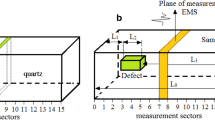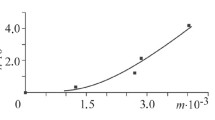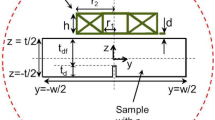Abstract
Background
Several methods have been used to detect defects or debonds nondestructively in materials or construction. Each of these nondestructive testing methods has advantages and limitations. Generally, they are suitable for testing a certain range or a specific type of material and structure and some of them require careful analysis to identify the features of the defects.
Objective
The present work proposes a nondestructive testing method based on electro-acoustic technique (NDTPEA) to detect internal defects of dielectric materials, which can identify the defects from the original stress wave generated at the internal defect surface.
Methods
Electric polarization occurs in the dielectric under the action of a high-voltage electric field. When the intensity of the electric field changes suddenly, the polarization charge generates a stress wave. If there are defects, such as cracks and debonding, in the medium, the position and size of the internal defects of the insulating material can be determined according to the stress wave.
Results
The waveform and velocity of stress wave is measured by a PVDF film. According to the velocity and time of the stress wave in the dielectric, the position of the internal defects or debonding of the specimen can be determined. The maximum error for measuring the wave transmission time is 1 ns, and the maximum measurement error in the defect thickness direction was 0.00253 mm.
Conclusions
In the NDTPEA, the detected wave originates from the vibration of the polarized charge at the defect, i.e., the defect is the source of the stress wave. The measured stress wave does not undergo any reflection or refraction, and the waveform is truly regular, without coupling factors. The wave shape and time characteristics can all reflect the characteristics of the defects.









Similar content being viewed by others
References
Honarvar F, Varvani-Farahani A (2020) A review of ultrasonic testing applications in additive manufacturing: Defect evaluation, material characterization, and process control. Ultrasonics 108:106227. https://doi.org/10.1016/j.ultras.2020.106227
Tant KMM, Galetti E, Mulholland AJ et al (2020) Effective grain orientation mapping of complex and locally anisotropic media for improved imaging in ultrasonic non-destructive testing. Inverse Probl Sci Eng 28:1694–1718. https://doi.org/10.1080/17415977.2020.1762596
Jhang KY (2009) Nonlinear Ultrasonic Techniques for Non-destructive Assessment of Micro Damage in Material: A Review. Int J Precis Eng Manuf 10:123–135. https://doi.org/10.1007/s12541-009-0019-y
Gholizadeh S (2016) A review of non-destructive testing methods of composite materials. XV Portuguese Conference on Fracture 1:50–57. https://doi.org/10.1016/j.prostr.2016.02.008
Garnier C, Pastor ML, Eyma F et al (2011) The detection of aeronautical defects in situ on composite structures using Non Destructive Testing. Compos Struct 93:1328–1336. https://doi.org/10.1016/j.compstruct.2010.10.017
Zaki A, Chai HK, Aggelis DG (2015) Non-Destructive Evaluation for Corrosion Monitoring in Concrete: A Review and Capability of Acoustic Emission Technique. Sensors 15:19069–19101. https://doi.org/10.3390/s150819069
Duchene P, Chaki S, Ayadi A et al (2018) A review of non-destructive techniques used for mechanical damage assessment in polymer composites. J Mater Sci 53:7915–7938. https://doi.org/10.1007/s10853-018-2045-6
Rus J, Gustschin A, Mooshofer H et al (2020) Qualitative comparison of non-destructive methods for inspection of carbon fiber-reinforced polymer laminates. J Compos Mater 54:4325–4337. https://doi.org/10.1177/0021998320931162
Gaal M, Caldeira R, Bartusch J et al (2019) Air-Coupled Ultrasonic Ferroelectret Receiver With Additional Bias Voltage. IEEE Trans Ultrason Ferroelectr Freq Control 66:1600–1605. https://doi.org/10.1109/TUFFC.2019.2925666
Senthil SM, Parameshwaran R, Nathan SR et al (2019) Non-Destructive Testing and Evaluation of Friction Stir Welded AA6063 Circularly Butted Pipes. Russ J Nondestr Test 55:957–966. https://doi.org/10.1134/S1061830919120106
Karch J, Dudak J, Zemlicka J et al (2017) X-ray micro-CT and neutron CT as complementary imaging tools for non-destructive 3D imaging of rare silicified fossil plants. J Instrum 12:1–6. https://doi.org/10.1088/1748-0221/12/12/C12004
Anouncia SM (2018) Digital interferometry with image processing and computational techniques for NDT of composite materials. Insight 60:685–696. https://doi.org/10.1784/insi.2018.60.12.685
Gorka J (2020) Assessment of the quality of abrasion-resistant plates welded joint. J Min Metall Sect B-Metall 56:209–220. https://doi.org/10.2298/JMMB190515010G
Jawwad AKA, Mohamed IK (2020) The combined effects of surface texture, flow patterns and water chemistry on corrosion mechanisms of stainless steel condenser tubes. Eng Fail Anal 109:104390. https://doi.org/10.1016/j.engfailanal.2020.104390
Daura LU, Tian GY, Yi QJ et al (2020) Wireless power transfer-based eddy current non-destructive testing using a flexible printed coil array. Philos Trans R Soc A-Math Phys Eng Sci 378:20190579. https://doi.org/10.1098/rsta.2019.0579
Beer O, Foessel J (2020) Experience in the Eddy Current Testing of Rolling Element Bearing Components. HTM-J Heat Treat Mater 75:236–247. https://doi.org/10.3139/105.110414
Lean MH, Wolak MA, Mackey M et al (2014) Internal Field Distributions in Multilayer Polycarbonate/Poly(vinylidene fluoride)–hexafluoropropylene Films at Onset of Breakdown. IEEE Trans Dielectr Electr Insul 21:800–808. https://doi.org/10.1109/TDEI.2013.004119
Liddell HPH, Mehrotra K, Lambropoulos J et al (2013) Fracture mechanics of delamination defects in multilayer dielectric coatings. Appl Optics 52:7689–7698. https://doi.org/10.1364/AO.52.007689
Levikari S, Karkkainen TJ, Andersson C et al (2019) Acoustic Detection of Cracks and Delamination in Multilayer Ceramic Capacitors. IEEE Trans Ind Appl 55:1787–1794. https://doi.org/10.1109/TIA.2018.2873989
Vellinga WP, Fedorov A, Hosson De JT (2007) Crack propagation along polymer/non-polymer interfaces. J Comput-Aided Mater Des 14:37-45. https://doi.org/10.1007/s10820-007-9063-z
Hanley TL, Burford RP, Fleming RJ et al (2003) A general review of polymeric insulation for use in HVDC cables. IEEE Electr Insul Mag 19:13–24. https://doi.org/10.1109/MEI.2003.1178104
Escurra GM, Mor AR, Vaessen P (2020) Influence of the Pulsed Voltage Connection on the Electromagnetic Distortion in Full-Size HVDC Cable PEA Measurements. Sensors 20(11):3087. https://doi.org/10.3390/s20113087
Kim HG, Jung HC, Park JD et al (2020) Measurement of Sheet-like Space Charge Distribution and Signal Calibration of Insulator XLPE Using PEA Method. J Electr Eng Technol 15:2027–2032. https://doi.org/10.1007/s42835-020-00477-8
Rizzo G, Romano P, Imburgia A et al (2019) Review of the PEA Method for Space Charge Measurements on HVDC Cables and Mini-Cables. Energies 12:3512. https://doi.org/10.3390/en12183512
Imburgia A, Romano P, Chen G et al (2019) The Industrial Applicability of PEA Space Charge Measurements, for Performance Optimization of HVDC Power Cables. Energies 12:4186. https://doi.org/10.3390/en12214186
de Moura HL, Silva VD, Guarneri GA et al (2020) Image-Based Ultrasound Speed Estimation in Isotropic Materials. IEEE Sens J 20:12903–12913. https://doi.org/10.1109/JSEN.2020.3002853
El-Hadad S, Ibrahim M, Mourad M et al (2019) Ultrasonic Detection of Microstructure Features in Ti-Alloyed Ductile Iron. Trans Indian Inst Met 72:2349–2358. https://doi.org/10.1007/s12666-019-01686-0
Acknowledgements
This work was supported by the National Natural Science Foundation of China under grant 11672350.
Author information
Authors and Affiliations
Corresponding author
Ethics declarations
Conflicts of Interest
The authors have no conflict of interest to declare.
Additional information
Publisher's Note
Springer Nature remains neutral with regard to jurisdictional claims in published maps and institutional affiliations.
Rights and permissions
About this article
Cite this article
Xu, L., Hou, Z. & Kang, H. A Method for Detection of Internal Defects of Dielectric Materials Based on Pulsed Electro-Acoustic Technique. Exp Mech 62, 417–426 (2022). https://doi.org/10.1007/s11340-021-00793-8
Received:
Accepted:
Published:
Issue Date:
DOI: https://doi.org/10.1007/s11340-021-00793-8




